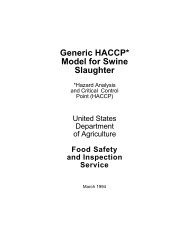Generic HACCP Model for Thermally Processed Commercial
Generic HACCP Model for Thermally Processed Commercial
Generic HACCP Model for Thermally Processed Commercial
You also want an ePaper? Increase the reach of your titles
YUMPU automatically turns print PDFs into web optimized ePapers that Google loves.
<strong>HACCP</strong> Plan Form<br />
The <strong>HACCP</strong> Plan Form is used to develop a Plant Specific <strong>HACCP</strong> Plan. This plan can<br />
serve as a useful guide, however, it is essential that the unique conditions within each facility be<br />
considered during the development of the plant specific plan. The first three columns on the <strong>for</strong>m<br />
are transferred from the CCP Determination Form. The fourth column is used to establish critical<br />
limits <strong>for</strong> preventive measures associated with each identified CCP.<br />
A Critical Limit is defined as a criterion that must be met <strong>for</strong> each preventive measure<br />
associated with a CCP. Each CCP will have one or more preventive measures that must be<br />
properly controlled to assure prevention, elimination, or reduction of hazards to acceptable levels.<br />
Critical Limits may be derived from sources such as regulatory standards and guidelines, literature<br />
surveys, experimental studies and subject matter or technical experts. The fifth column is used<br />
to establish monitoring requirements.<br />
Monitoring is a planned sequence of observations or measurements to assess whether a<br />
CCP is under control and to produce an accurate record <strong>for</strong> future use in verification. Monitoring<br />
is essential to food safety management by tracking the <strong>HACCP</strong> system's operation. If monitoring<br />
indicates that there is a trend towards loss of control, then action can be taken to bring the<br />
process back into control be<strong>for</strong>e a deviation occurs. Monitoring provides written documentation<br />
<strong>for</strong> use in verification of the <strong>HACCP</strong> plan. All records and documents associated with CCP<br />
monitoring must be signed or initialed by the person doing the monitoring.<br />
Column six is used to establish corrective actions to be taken when monitoring indicates<br />
that there is a deviation from an established critical limit. Where there is a deviation from<br />
established critical limits, corrective action plans must be in place to: 1) determine the disposition<br />
of non-compliant product; 2) fix or correct the cause of non-compliant product to assure that the<br />
CCP is under control; and 3) maintain records of the corrective actions that have been taken<br />
where there has been a deviation from critical limits. Because of the variations in CCP's <strong>for</strong><br />
different processes and the diversity of possible deviations, plant specific corrective actions must<br />
be developed <strong>for</strong> each CCP. The actions must demonstrate that the CCP has been brought under<br />
control. Documentation of the corrective actions taken must be signed by the individual<br />
responsible <strong>for</strong> taking corrective actions.<br />
Column seven is used to establish effective recordkeeping procedures that document the<br />
<strong>HACCP</strong> system. The maintenance of proper <strong>HACCP</strong> records is an essential part of the <strong>HACCP</strong><br />
system to document that each CCP is under control and to verify the adequacy of the <strong>HACCP</strong><br />
plan. Records serve as: 1) a written documentation of the establishment's compliance with their<br />
<strong>HACCP</strong> plan; 2) the only reference available to trace the history of an ingredient, in-process<br />
operation or a finished product, should problems arise; 3) a ready source of in<strong>for</strong>mation to<br />
identify trends in a particular operation that may result in a deviation if not properly corrected;<br />
and, 4) good evidence in potential legal actions. In accordance with the <strong>HACCP</strong> principles,<br />
<strong>HACCP</strong> records must include; records associated with establishing and monitoring CCP’s and<br />
53



